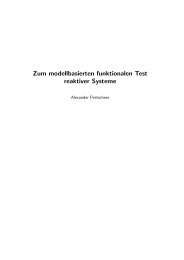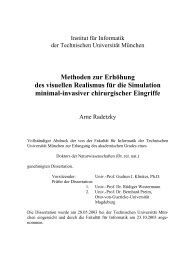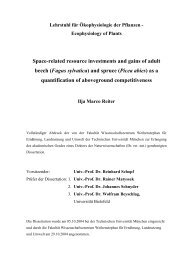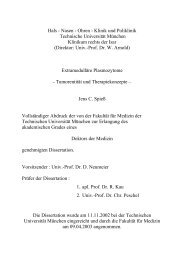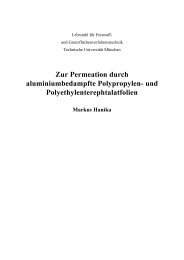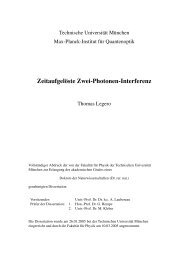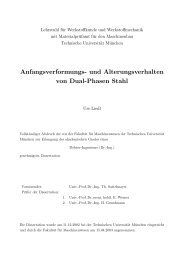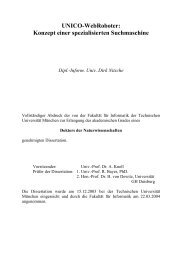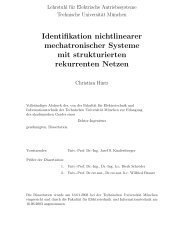Topologically Defined Neuronal Networks Controlled by Silicon Chips
Topologically Defined Neuronal Networks Controlled by Silicon Chips
Topologically Defined Neuronal Networks Controlled by Silicon Chips
You also want an ePaper? Increase the reach of your titles
YUMPU automatically turns print PDFs into web optimized ePapers that Google loves.
CHAPTER 2. NETWORKS OF DEFINED TOPOGRAPHY<br />
connections in vitro [65, 66, 106]. Small networks of only a few neurons perform tasks such as generating<br />
the rhythm for feeding and breathing. Due to their simplicity, these networks are ideal for studying<br />
principles of information processing at a single cell level. N.I. Syed et al. were able to reconstruct the<br />
central pattern generator that controls the animal’s breathing rhythm, from dissociated neurons in vitro<br />
[105]. However, these identified neurons, R.Pe.D1, V.D4 and Ip.3.1, are difficult to isolate. Generally,<br />
the number of cells forming chemical synapses in culture is very small.<br />
The A-clusters of the two paired pedal ganglia comprise about 60 cells with similar electrophysiological<br />
properties [98] and electrical synapses between them [58]. Due to the large number and diameters<br />
ranging from 40µm-70µm, A-cluster neurons are ideal for designing artificial neural networks in vitro.<br />
A more pragmatic reason for choosing Lymnaea stagnalis and not Aplysia californica, an even better<br />
analyzed mollusk with equally promising neural properties, as a neuron donor is Lymnaea’s simple<br />
and robust nature and its availability. The snails are kept in four 200L basins that are cleaned twice<br />
a week. They are fed on lettuce and fish food pellets. To prevent inbreeding or population decreases<br />
due to reproduction rates not matching the number of animals needed, new snails are added at irregular<br />
intervals. A quarantine basin prevents the contamination of the laboratory stock with parasites.<br />
2.2.2 Culturing neurons from Lymnaea stagnalis<br />
The isolation and culture of Lymnaea neurons follows protocols from the literature [90, 107], with<br />
minor modifications. For a detailed, well illustrated description see [49].<br />
All steps, except the removal of the shell, are executed under sterile conditions in a flowhood. Dissection<br />
instruments are either autoclaved or soaked in a solution of 70% ethanol and 30% water prior to the<br />
preparation. The entire procedure is divided into two parts, the isolation of individual neurons including<br />
their positioning on the chip, and the subsequent cell culture to enable neuronal outgrowth and synapse<br />
formation. While the general aspects are outlined below, details of single steps and recipes for solutions<br />
and culture media are described in appendix A.<br />
Isolation of individual cells<br />
Animals with a shell length of 1.5cm-2cm are selected from the laboratory stock and deshelled. They<br />
are soaked in antibacterial solution for 5min to remove dirt and bacteria and to anaesthetize them. They<br />
are then pinned to a culture dish with a rubber coating at its bottom which is filled with antibiotic normal<br />
saline (ABS). An incision is made on the dorsal surface from the mouth to the visceral mass. The body<br />
wall and internal organs are pinned aside to expose the brain, consisting of a loop of ganglions located<br />
at the end of the buccal mass, see fig. 2.4B for a sketch of the snail at this stage of the preparation. Next,<br />
the cerebral commissure and the esophagus are cut with fine scissors and the buccal mass is removed.<br />
After cutting the remaining nerves connecting the ganglia to the body, the central ganglionic ring is<br />
transferred to a small dissection dish also filled with saline.<br />
To extract individual neurons, the brains are pinned to the rubber coated dish and the outer sheath,<br />
the connective tissue surrounding the ganglia, is carefully removed with fine tweezers. The saline is<br />
exchanged to remove debris and tissue parts. Central ganglionic rings now look like the one shown in<br />
fig. 2.5A. After 15min, during which the brains recover from the previous step, they are treated with an<br />
enzyme solution for 27min-33min. The enzymes partly digest the extracellular matrix, thus facilitating<br />
the isolation of individual neurons from the ganglia. The brains are then washed three times with defined<br />
medium to remove the enzymes and are incubated in trypsin inhibitor for 15min, which inactivates<br />
any trypsin remaining in spite of the previous washes. Following three more washes, the medium is<br />
replaced with high osmolarity defined medium. The increased osmolarity causes a slight shrinkage of<br />
the neurons that makes the somata less susceptible to mechanical damage and facilitates their isolation.<br />
The inner connective tissue sheath surrounding each ganglion is opened with a microneedle, and indi-<br />
12


